
King Gizzard’s Lo-Fi Gut Feeling
From modding microtonal guitars, to scrunching up a VHS master tape, and recording at Daptone in Brooklyn, psych rockers King Gizzard & The Lizard Wizard will do anything and go anywhere to get creative.
I’ve been tracking King Gizzard & the Lizard Wizard since early 2012. The closest I’ve come to cornering the seven-headed beast was a routine studio tour of Paul Maybury’s Secret Location Sound Recorders, where the Gizz had been holed up the week before. It’s the perfect Gizzard nest, with enough room to sprawl out across the defunct textile factory floor.
I mustn’t be a very good tracker, because King Gizzard’s breadcrumb trail is a non-stop buffet. In the four years since my almost encounter, the band has released a whopping eight albums! The latest is Nonagon Infinity, which may or may not be their latest release by the time this goes to print. Rumour has it, there might be four Gizzard albums released in 2017. Prince was prolific; these guys are dropping more tasty treats than Hansel and Gretel.
I finally tracked down lead singer and head Gizzard, Stu Mackenzie, for a chat while he was hiking the mountains of Utah as a bit of R ’n’ R before a non-stop 30-day tour of the US. When he arrived back home in Brunswick East, he invited me into drummer Eric Moore’s Flightless Records’ headquarters, where King Gizzard have fashioned a studio out of the remainder of the first floor tenancy. There’s not much too it, a handful of stud walls covered in carpet tiles, rugs on the ground and a makeshift wall of office dividers that distinguishes the control room from the live room. This is DIY.
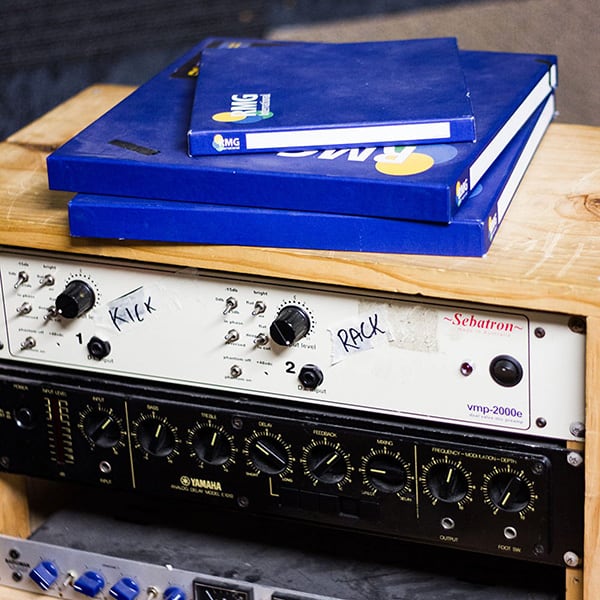

LEGEND OF DIY
That’s always been the broader legend surrounding Gizzard; that they’re a psych-rock collective with such a fervour for DIY you’ll just as easily find them with a Stanley knife gritted between their teeth as a guitar in their hands. In many ways, the myth holds true. Drummer Joe Walker has been recording Leah Senior at Gizz HQ, Ambrose Kenny-Smith and Cook Craig are in another Flightless band The Murlocs, second drummer Moore runs Flightless, and Stu works full-time on Gizz, producing and recording their music via any medium, including reel-to-reel analogue tape, direct to digital, even VHS.
Still, despite Gizz’s army of creative go-getters and a habitable recording space, the band has always displayed a healthy habit of bringing in outside contributors. For instance, producer/engineer Paul Maybury has been a constant collaborator, and Secret Location is like a second home to the Gizz. Likewise, Jason Galea, who dreams up all the artwork for the band has a space at Flightless HQ. Even across the ocean, the band has a relationship with tape op and engineer Wayne Gordon at the home of Daptone in Brooklyn, New York, where the band recorded most of Nonagon Infinity.
It’s famously hard to get into the Daptone studios, either you’re on head engineer Gabriel Roth’s radar, or a friend of a friend. “We were in New York a couple of years ago and had some songs and time,” said Stu. “We managed to get an inside phone number off a friend of a friend so we just called up and explained what the go was. We were all intimidated at first because it was prestigious and they’re complete analogue nuts. We didn’t have very cool gear at the time; I had some ’80s Peavey combo amp. They’re such down-to-earth, awesome crew though. We’ve recorded there a few times over the years. They have a pretty similar aesthetic or view of what recorded music should be.”
I opened up a VHS machine, and it’s like a mini reel-to-reel. I ended up mixing that whole record to VHS
Daptone is what Flightless and Gizz might look like in a few more years. Both built their own studios, both record their own material and both independently release their work. While Daptone has become a modern soul mecca — with Amy Winehouse recording there and neo-soul revivalists Sharon Jones & The Dap Kings essentially resident artists — Flightless has become the East Coast home of Aussie experimental psych rock. The West Coast is well catered for by Tame Impala et al.
There’s no one style or record King Gizzard & the Lizard Wizard make. Sometimes gear and recording format has an influence, other times the concept behind it, and occasionally a crop of songs that don’t suit any other album end up together, which was the case with previous album, Paper Mâché Dream Balloon. It has a more acoustic bent — with heavy use of the flute — and was recorded and mixed digitally, which contributes partly to its relatively ‘hi-fi’ sound. “I don’t know if your average person would call it hi-fi,” said Stu. “But it’s the only record we’ve made that’s not tapey. There was some fork in the road where it could have gotten really warped, wobbly and saturated. But I deliberately didn’t want to rely on effects and weird sonic shit.” Mikey Young from Eddy Current Suppression Ring mixed the album, and he sent back mixes that were “pretty clean, and it just felt right.”
In the same year, they released Quarters, featuring four extended jams that each come in at an OCD-appeasing 10 minutes and 10 seconds. Stu mixed that one… onto VHS. “I opened up a VHS machine, and it’s like a mini reel-to-reel,” explained Stu. “The sound on VHS is actually pretty hi-fi if you have a new tape. I ended up mixing that whole record to VHS, which was a cool experiment. You can hit the tape pretty hot and get a nice saturated sound. After that, you can rip all the tape out of the VHS then crinkle it, step on it and warp it. When you wind it all back in and play it, you get some pretty cool sounds. That’s where all the wobbliness of that record comes from.
“I love experimenting with tape. It’s so fun how it’s a real, physical thing and you never know exactly what’s going to happen. There’s an element of immediacy and maybe a little danger in there.”


MICROTONAL IMPROVEMENTS
As well as messing around with different technologies, King Gizzard are constantly putting themselves in unknown musical territory to see what comes of it. On the walls of the studio are a collection of guitars and basses the band has been experimenting with for the upcoming record. They’ve been re-fretted with microtonal positions so they can’t play in a traditional Western voicing.
There are a few constants though. Stu loves Electro-voice mics, he has piles of 635 omni directional mics lying around the place, and “for a pretty long time I’ve used an Electro-voice RE-20,” he said. “It’s the best microphone I own by a pretty long way. The diaphragm is pretty far in it so you don’t really have to use a pop filter. You can get a really in-your-ear, straight-up, true sound. I use one for kick drums too so it’s a good combo mic. It’s got similarities with a Shure SM7, but the SM7s are more bass-heavy, they sound more like modern radio whereas the RE-20 sounds like ’70s radio.”
On the other hand, some things have been constant in their absence. “I haven’t added reverb to a Gizz record for a couple of years,” reckoned Stu. “If you can record something in a space which has a general room sound, you can saturate it enough so it sounds like it has reverb. I do have one of those big yellow Danelectro Spring King pedals, which can be pretty cool as a studio tool. That’s that sound on Hot Wax that keeps coming in, I was just punching one of those.”
Nonagon Infinity was primarily tracked at Daptone because Stu felt like the record should come together as a seven-piece live project. “I just didn’t want to have the responsibility of making sure mics sounded good and having to start the tape or hit record if we did it digitally,” noted Stu. They then recorded most of the overdubs in their own studio, and re-recorded some undercooked songs — Big Fig Wasp, the jazzy part of Invisible Face and the intro and outro to People Vultures — at Secret Location.
Each record seems to either start with or come around to a specific intention; Nonagon Infinity was to be their heaviest record. “It was a bit of an ambitious project, a lot of mental energy went into it,” said Stu. “We wanted to experiment with different time signatures and make a never-ending record with all the songs interconnected, not only at the start and the end but recurring themes within them.
“On top of that we wanted to record it as a group which should probably make it easier, but seems to make it harder for us. We’ve been accumulating these songs over the last 18 months, and there was a lot of rehearsal.”
THE DAWN OF THE WIZARD
Stu never imagined King Gizzard & the Lizard Wizard would still be here today, or ever have really formed into an entity. It started out as his own pet project, a rambling jam band in high school that spent a year playing together and making ‘silly demos’ before recording anything. His first recording setup was a computer with one of those plasticky, grey gooseneck mics. Stu remembers his friends all had them, and they “sounded absolutely awful, but it was this magical thing.” He was 15, and could record sound on sound with his copy of Cubase in Windows 2000. He was hooked. Later, he got an Mbox, a Shure SM57 and a harmonica mic, which was the gear he mainly used to record their second album Eyes Like the Sky. He’s also had various other devices; an eight-track Zoom digital recorder, a four-track cassette recorder.
Even back then, when lo-fi was really the only level of quality available, he was drawn to the aesthetic. “I can’t think of a time when I’ve been drawn to anything contrary to that,” figured Stu. “Even around that time of discovering the computer mic setup, I was pretty deeply into the ’60s garage hole. There’s this temptation to make things sound super-subby and super-toppy, but I’m more inclined to make things sound boxy. It’s more of a things bouncing off your ears in a small room vibe. It sounds counter-intuitive, but to me it’s a bigger scope to explore than the quest for the most hi-fi or 20Hz to 20kHz-filling sound. It’s more of an exploration to see what you can do inside that box rather than fill it.
“I still labour over music but in a different way. I’m not tweaking a kick drum for two hours, like some people do. It is quicker in a lot of ways, but it’s also pretty easy to make lo-fi music that sounds bad. At the end of the day you’re trying to capture that feeling of your ears compressing at a loud concert. It sounds like it’s distorted because it’s loud and your brain is in this state of trying to comprehend what’s happening. Being able to capture that in a way that sounds right when you listen to it in headphones on the bus is hard to do in hi-fi.”
Nowadays he has a Tascam 38 eight-track reel-to-reel connected to a Soundcraft FX16ii 16-channel analogue console, Sebatron VMP-2000e dual preamp, Yamaha E1010 analogue delay, and a Radioman compressor. It all eventually ends up in Ableton Live — if he’s not recording direct to digital — via an RME Fireface 800, with KRK Rokit 8s and a Presonus Monitor Station for monitoring.
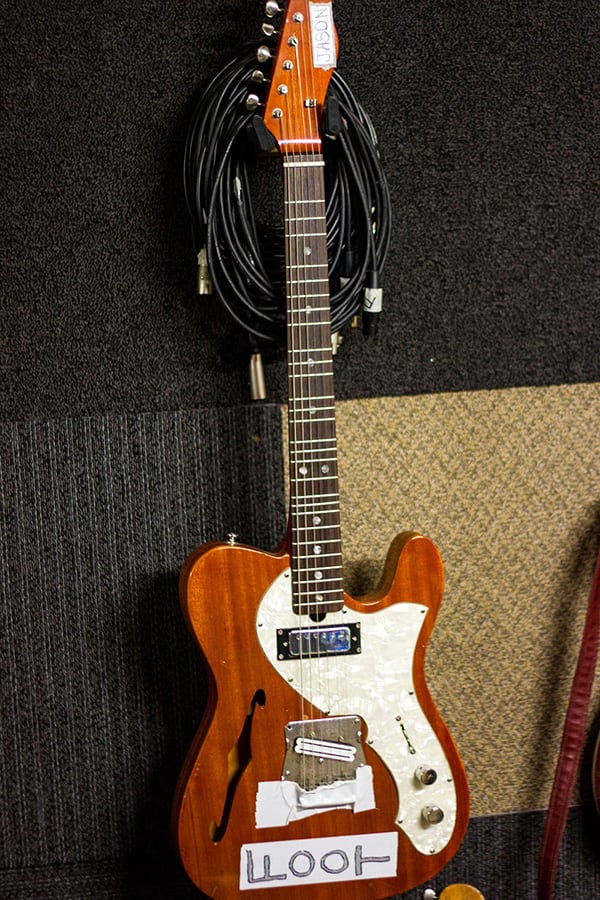
EAR COMPRESSING GOODNESS
To reach the zenith of saturation required to capture that ear-compressing feeling took multiple stages. “There’s saturation on every degree of this record,” noted Stu, which began at Daptone. The studio is religiously analogue, with everything ending up on an eight-track Ampex 440 tape machine. “Recording a 7-piece on an 8-track because means you get a track each,” said Stu. “The eight lines were made up of three guitar lines, two tucked under the Rhodes and another under the piano with a mic on each, a bass DI, and a single ribbon over the right shoulder and kick mic either inside or a little bit out for each kit. Cav used the house kit and it was kept as two tracks. We pieced Eric’s together, which took half a day to get right, and it was summed down to one track. Ambrose had the final line, which was either harmonica or keyboard. It’s somewhat limiting, but also liberating doing everything like that.
“It’s pretty dead in there, and they’ve got baffles, but it’s a small room and naturally gets pretty clonked together, so there’s lots of bleed. Everything’s in the red and pretty compressed on the tape. It was almost a battle to gain some level of clarity on the record. Then once there was enough clarity, we’d blow it all back out again so it was just the right amount of wrongness.”
MR BADGER STEPS UP
Being a King Gizzard collaborator just requires one thing; that you get it. That you’re completely fine with phasing a stereo master, or printing the mix to a roll of VHS tape then scrunching it on the floor if that’s what the aesthetic requires. Mixers have to leave any notion of ‘doing it the right way’ at the door. Ignoring any voices that suggest ‘6dB of gain reduction is my limit’ or ‘that’s too much saturation.’ Those are just roadblocks on the way to ‘the sound’ for Gizzard.
Mix engineer, Michael Badger, has mixed a handful of Gizzard tracks over the years, including a few off In Your Mindfuzz. “He fully gets the vibe; there are a lot of people who wouldn’t get it at all,” said Stu. “He did an amazing job. It’s good working with him because I’d just go over to his house and we’d sit there and mess with stuff.
“Are you supposed to do that? Put tape saturation plug-ins on stuff recorded to tape?” Michael Badger asked, half facetiously, when we talked about the Nonagon Infinity mix. He’s subscribed to the Tchad Blake school of thought, “I always approach things like there’s no rules, just do whatever it takes to make it sound how you want it.” Whether it’s layering tape saturation on tape saturation, rolling off drums at 5kHz, or vice versa, adding a sample to a Daptone-recorded kit for a bit more low end thud.
Michael can testify to the speed of King Gizzard’s operation. “Stu is the fastest musician I’ve worked with,” he said. “You’ve got to keep on your toes to keep up. When you’re working with Gizzard, you don’t have time to re-think anything, it all happens in a blur.” The sessions at badger’s Jaya Jaya Studio started off with Stu finishing the lead vocals in a veritable flash. “He did all nine tracks in about four hours,” recalled Michael. “Then he went away and did overdubs, and I’d mix it into the stuff he’d recorded in America.” While he was toying with the idea of sending tracks out to hardware, Michael ended up keeping the entire project in the box because of the tight deadline. This time — unlike In Your Mind Fuzz, which Michael mixed a few songs on — Stu didn’t apply overarching effects like chorus and flanger across the master. It was a decision Michael thought a good one, allowing Nonagon Inifinity to come across more brutal. However, even though Stu had brought in Megadeth as a reference, asking ‘How metal can we go?’ It still took him a while to get used to how brutal Michael’s first mix of opener Robot Stop actually was. Michael: “When I sent it to Stu, he said, ‘I need to listen to that again.’
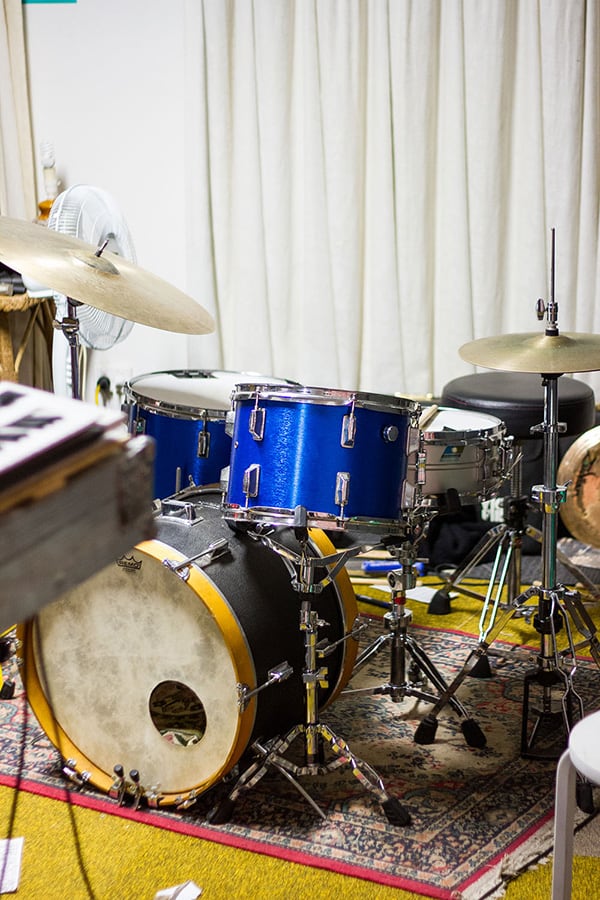

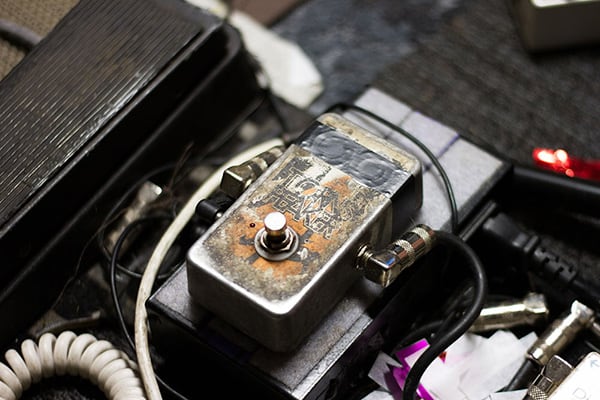
A BED OF EIGHT TO LIE IN
Michael quickly gelled with the idea of mixing a bed of only eight tracks. Having less tracks to play with is a big positive when mixing a Gizzard song. “There’s so much going on in the tracks you just need to find space for all the chaos,” said Michael. “Luckily, apart from track two, the album was sounding pretty similar. Once you got it up and running, good songs mix themselves.”
Track two, Big Fig Wasp, was recorded at Secret Location, and was relatively more hi-fi than the Daptone material. “There was a lot more top end,” explained Michael. “The way they recorded at Daptone was pretty old school and sounded like something recorded in 1970. There was little bit of EQ matching, especially on overheads, and on that one song I could absolutely smash the snare if I wanted to as opposed to not having a mic on the snare from the eight track sessions.”
Overall, he really enjoyed mixing the songs recorded at Daptone. “A lot of the time I was knuckling out sounds I didn’t like, then go back and make subtle changes,” he said. “I’ve probably never tried getting such a big drum sound out of two mics before. I duplicated the kick on one of the kits and added a really low end sample. At the time, I was really obsessed with Tchad Blake. I watched about every interview there is of him on the net. And he encourages people to stop worrying about being so authentic and old school. If you think you need a little bottom end in the kick, then mix in a sample. It puts a little thud in there to make the kick really pump through.
“It’s always hard working out what you’re going to do with two drummers. Do you pan them hard left and right? We made the decision early on they needed to be a little separated. Even though they do the exact same thing, one seems to lead and the other drummer follows. On most of the songs, we got rid of one of the kicks and put the lead drummer’s kick right up the middle. I had the lead drummer, Cav, a little cleaner. I used Decapitator’s punish button on Eric’s (second drummer) overhead and pushed it out to the right. I was using it more for brutal effect.
“PSP Vintage Warmer 2 is one of my favourite plug-ins, it gave the drums good punch and glued it together. I don’t usually, but on this record I used the Waves C4 multi-band compressor on the master bus because I didn’t want to compress the top end. There was already a lot rolled off between 8-10kHz, particularly on the drums, some from 5-6kHz. I wanted it to be more of a thuddy-sounding drum kit, without any splashiness in the top end.”
The bass was DI’d, which produced a warm, fuzzy clean sound that Michael instantly got to work on. “I ran it through a Softube bass amp and Decapitator,” he recalled. “I ran it out to a parallel bus with a chorus effect on the bass between 500Hz and 1kHz to get some really cool stereo width. On some of it I used a stereo flanger. With the two drummers being quite big and full, I needed the bass to be wider, rather than straight up the middle. I always had to keep in mind that Gizzard release on vinyl, so you have to be a bit careful when you put low end on the side.
Michael had only just picked up the Soundtoys bundle of effects plug-ins before mixing the album. As well as loads of Decapitator, the first time Michael opened the Little Alterboy plug-in was for a vocal effect at the start of Robot Stop. Besides the Soundtoys plugs, he used Waves Kramer Tape, UAD’s Pultec Pro EQ on a few things and the Shadow Hills Industries mastering plug-in, which has become his, “go to on the master bus, run really gently. From my experience using the hardware at Sing Sing, Universal Audio has done a great job of emulating that sound.”
The guitars were treated to a diet of PSP’s Microwarmer and Decapitator to make them even more crunchy and distorted. “It’s great with Stu, he just plays me a couple of old school metal tracks and says, I’d like it to sound more like this.’ Then he lets me go with it. There are six guitar overdubs that come in and out of the track, and I needed to make sure they slot in nicely. They have a metal pedal on some of the tracks, so if you’re cooking too much it can take up all the space in your ears.”
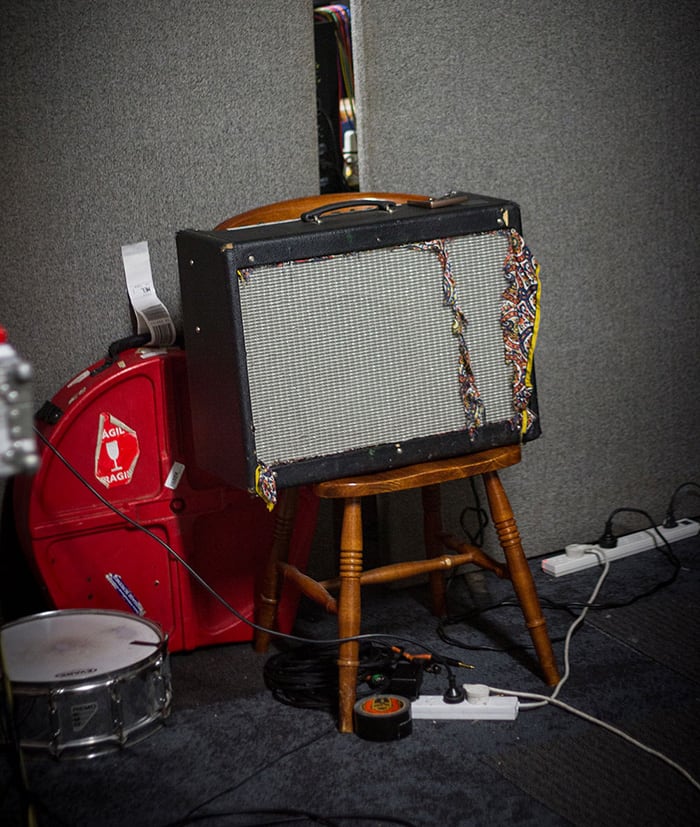
CONNECTING THE INFINITE LOOP
The final hurdle was to collect all the tracks together into a recurring loop, which Stu and Michael tag teamed on. Michael: “He would send me roll back of 30 seconds before the song would begin, and then an extra 30 seconds or minute at the end of the song. When I sent him the mixes, he’d then paste them together where he wanted one track to fade into another. It was the reason I wanted to mix from track one to nine. I needed to get the flow of it.
“A few of the songs were done at Secret Location, so the interlude bits had a slightly different sound, which I liked, because it gives your ears a break. The first mellow song on the record is Mr Beat, and that’s track five. I was worried with the first four tracks being so chaotic that track five would be a bit late for an ear break. But the slightly different sounding interludes and changes in sonics from song to song felt like a little break for your ears.”
While Michael was flat out, things weren’t moving quickly enough for Stu. “I got a bit pedantic with this record because it was such a long time in the making and it started driving me insane,” he said, which still didn’t stop him from fiddling with the final mixes once and for all. “He’d send me a mix back, then I’d realise I wanted to add something, so I’d put his mixes back into my session and add things in. It caused the record to be really out of phase in some spots which the mastering guy thought was pretty funny! It also added to the blown-outness as well; there’s a fair few layers being saturated.”




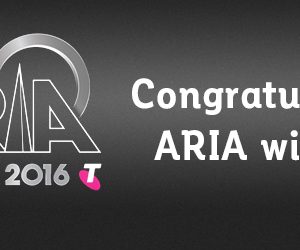











RESPONSES